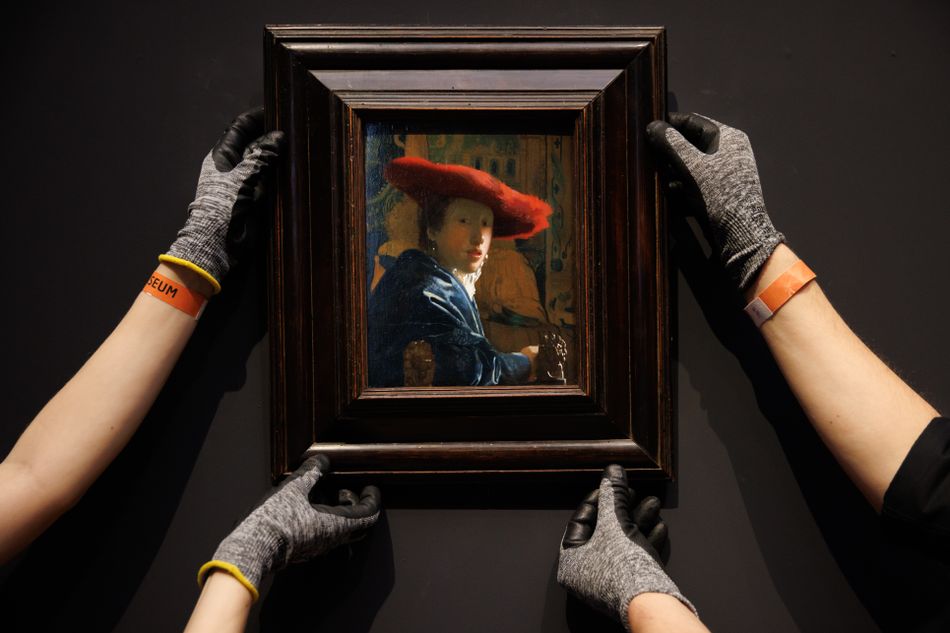In Johannes Vermeer’s The Love Letter, painted around 1670, we see a woman dressed in the sort of yellow, fur-trimmed jacket we encounter repeatedly in the artist’s oeuvre. Sitting at the centre of a high-ceilinged room, she is holding the neck of a lute in her left hand and a small, rectangular object in her right. She has half turned around. A servant girl is standing behind the woman, looking over her right shoulder. Having lingered in front of this painting for a while, a visitor to the Amsterdam Rijksmuseum’s magisterial Vermeer exhibition says to her companion: “You sort of expect her to say: ‘Were you looking at my phone screen?’”
The woman in the picture is not holding a phone, of course, but a sealed envelope, the eponymous love letter, delivered by her servant, who would have been the go-between for delicate missives like this in the 17th century. And yet, the anachronistic phone remark is not quite as silly or arbitrary as it may first appear. In our perception of art, we are, after all, limited by the perspective of own times. This perspective is hard to escape, no matter how much we try to assume that of the period in which the work was made, to take into account its social conventions, its taboos and iconographic signals.
However, Vermeer is a special case. In his world, we obviously encounter historical settings, but also a kind of heightened human reality that seems independent of any particular epoch. The meaning of his scenes is vague, and this very vagueness lends his gently wistful women and smirking cavaliers their universality. There is a deceptive simplicity to the compositions of his interiors. In fact, when viewed together, they might feel almost monotonous, if it weren’t for what one might call the tension of potentiality—nothing much happens, but anything seems possible—another reason the solitary figures and subtly interacting groups depicted here can be read as representatives of humanity at large, and not just of Vermeer’s “Golden Age”.
Much has been said and written about the self-contained aura of Vermeer’s women reading letters, making lace, sitting at the harpsichord, looking at themselves in the mirror or pouring milk into a bowl. That same quality, however, is also displayed by women who have company, particularly male company.
One of the most fascinating examples is The Glass of Wine (1659-61) from the Gemäldegalerie in Berlin: we see a room furnished with a bench, two chairs and a table, which is covered with an elaborate, colourful cloth. Hung on the back wall is a painting in a golden frame. The window is on the left of the room, as is usual in Vermeer. It is open. Daylight falls on a man in an olive-coloured cloak and a large dark hat, standing just off-centre. He holds a wine jug. To the right, a woman in a sumptuous red dress and a white bonnet sits on a chair. She is holding an empty wine glass to her mouth, its stem horizontally pointing away from her face.
The longer one looks at this gallant scene, the less clear it becomes: the man is obviously not a servant, yet he is also not holding a glass himself. What is his relationship with the woman? Is he trying to get her drunk? He certainly seems eager to refill the glass she has just emptied. There is nothing crude or superficially erotic about this, but it is slightly unsettling nonetheless.
The woman is the most interesting element in the painting: the rim of the glass covers her eyes; the bonnet serves as an additional protection, shielding her from our gaze as much as the man’s. You do not expect her to put the glass down any time soon. Is she hiding? Contemplating her next move? Lost in her own world? We don’t know.
Scholars assume that in the 22 years in which Vermeer was active as a painter, from 1653 to 1675, he created between 45 and 60 pictures. Compared to the production of his contemporaries, this is not a lot, an average of two to three paintings per year. The surviving works are normally spread across 19 collections in seven different countries. Gregor Weber, head of the Fine Arts Department at the Rijksmuseum, has managed to gather a sensational number of Vermeers in one place: 28 of 37 (some say: 36) originals can be seen in Amsterdam. There are a few notable absences, such as The Guitar Player from Kenwood House in London, The Music Lesson from the Royal Collection and The Girl with the Wine Glass from the Herzog Anton Ulrich-Museum in Braunschweig. Even so, the Rijksmuseum show is an extraordinary, once-in-a-lifetime opportunity: instead of having to travel to Tokyo, New York, Washington, Edinburgh, Berlin or Paris, one can walk from piece to piece, which feels like a stroll through Vermeer’s own rooms.
The last time some of these could be seen together was six years ago, in Paris. The Louvre had gathered 12 Vermeers as the core of a show that presented them in the context of the works of important contemporaries such as Gerard Dou, Jan Steen and Pieter de Hooch. What that exhibition made clear was that other Flemish painters prepared the change of perspective, especially the brilliant Gerard ter Borch, whose pictures foreshadowed some of the things that would be found in Vermeer’s work shortly afterwards. But none of them was quite like him.
Forgotten for almost two centuries, Vermeer was famously rediscovered in 1866 by French critic Théophile Thoré, who aptly named him the “Sphinx of Delft”. However, what we know about the artist’s life does not make him seem particularly enigmatic as a person. He was born in Delft in 1632, the son of a silk weaver who also ran a pub near the Voldersgracht canal, “De Vliegende Vos”. Nothing is known about his education and his youth. He joined the Guild of Saint Luke as a master painter in 1653. In the same year, he married Catharina Bolnes, who came from a socially higher-ranking family than his own.
This marriage may have made it necessary for the Calvinist Vermeer to convert to Catholicism. Between 1657 and 1670, the artist enjoyed the support of the wealthy collector Pieter Claesz van Ruijven and his wife, Maria de Knuijt, who together bought up about half of his works. Due to the invasion of French troops in 1672, the economy in the Netherlands deteriorated dramatically. Vermeer got into severe financial difficulties, and when he died in 1675, he left his widow and his numerous children a mountain of debt. Catharina apparently had to give some of his paintings to a neighbouring baker in exchange for bread.
Those sparse details do not really move us any closer to solving the conundrum of Vermeer’s work (although an interesting new book by curator Gregor Weber, Johannes Vermeer: Faith, Light and Reflection, sheds new light on the circumstances of his possible conversion to Catholicism). Even if we knew more about him, it still seems unlikely that a positivist approach would be useful in terms of understanding his art. Though most of his paintings appear to reflect the reality of everyday life in his time, they are neither biographical nor “realistic” in any strict sense of the word. In his interiors, we encounter a fly-on-the wall observation of private lives that always retain their inscrutability.
The artist’s shift from early religious and mythical motifs to genre painting—which is to say, painting of everyday scenes—denotes his search for his own style. A series of close-up interiors is followed by several paintings of two or three figures, a development that is suddenly interrupted by The Milkmaid (1658-59). This painting, which shows a single figure, marks Vermeer’s breakthrough to a style entirely his own. He reduces the number of objects and colours in the works that follow, in which large individual figures feature in a quiet plot, such as the Woman with a Pearl Necklace (1662-65) and The Woman Holding a Balance (1662-64), both of which are similar to The Milkmaid in terms of spatial design. In his late genre paintings from 1665 onwards, such as The Love Letter, the figures are shown on a small scale in spacious interiors.
Our visual habits not only make us half-expect smartphones to feature in these baroque paintings, they also prompt us to project our own contemporary issues onto them. When a climate activist recently glued his head to The Girl with the Pearl Earring (1665-67) at the Mauritshuis in The Hague, it was not merely a gesture of protest against a phenomenon that is very much of our own age. There was also an impulse to see this act as a kind of symbolic assault, not just on a work of art, but on the girl herself.
This is, of course, a category mistake in more than one sense, the obvious one being the equation of a picture with a person. A more subtle one stems from the fact that The Girl with the Pearl Earring is not actually a portrait. It belongs to the Flemish type of the so-called tronie. These are head and character studies, archetypal amalgamations of idealised features. In the case of The Girl with the Pearl Earring, this artistic convention probably allowed Vermeer to defy the etiquette of his time, as a young woman would not have stared so directly at anyone. She would modestly have lowered her gaze, particularly when interacting with a man.
The same is true for two paintings from the Andrew W. Mellon Collection in Washington DC, both of which currently hang in the same room as Vermeer’s most famous work: Girl with a Red Hat and Girl with a Flute (the attribution of the latter to Vermeer is not unanimous). They were painted around the same time as The Girl with the Pearl Earring, between 1664 and 1667, and look as directly and confidently at the viewer as she does.
Being used to the spectacle of ubiquitous, identity-curating selfies on Instagram or TikTok, we are both fascinated and slightly disturbed by these composite faces. While the mass of pictures we are exposed to daily is threatening to make us indifferent to single images, these paintings made in a time of very few images have the power to stop us in our tracks and stir a desire to explore the overt and hidden meanings they are saturated with. Like so many aspects of Vermeer’s work, the idealised tronies strike us as both familiar and distant.
Few artists have come close to what Vermeer achieved by placing quiet people in quiet rooms. The works of those who have are either more eerie, such as the scrubbed interiors of Vilhelm Hammershøi, or much sadder, like those of Edward Hopper. Johannes Vermeer remains one of a kind while staying universal. His work is both specific and intangible, genuine and staged, human and artificial. Viewers from every era will find themselves reflected in the serene world Vermeer created, precisely because it is an autonomous domain of its own.













